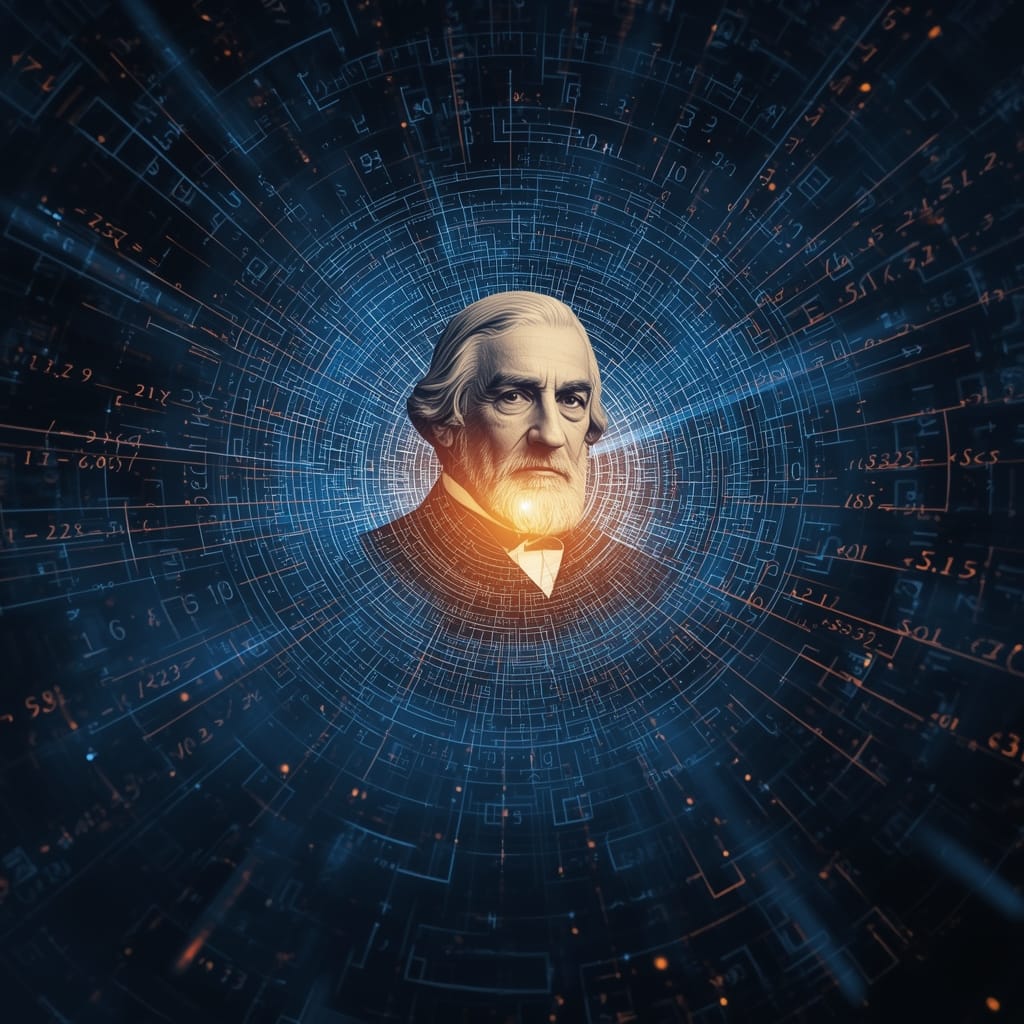Last Updated on September 14, 2025 6:58 pm by Laszlo Szabo / NowadAIs | Published on September 14, 2025 by Laszlo Szabo / NowadAIs
The Dawn of AI-Powered Mathematics: Gauss AI Conquers the Strong Prime Number Theorem – Key Notes Section
- Unprecedented Speed Achievement: Gauss AI completed the Strong Prime Number Theorem formalization in just three weeks, compared to 18+ months of human expert efforts, demonstrating the potential for AI systems to dramatically accelerate mathematical research and formalization processes.
- Human-AI Collaboration Model: The success represents a hybrid approach where human mathematicians provided strategic guidance and conceptual direction while Gauss AI handled detailed formal proof construction, suggesting an optimal partnership model for future mathematical research.
- Technical Infrastructure Scale: The formalization required over 25,000 lines of code and 1,100+ theorems/definitions, coordinated across thousands of concurrent AI agents working up to 12 hours each, showcasing the computational scale needed for complex mathematical AI applications.
A Mathematical Breakthrough
The mathematical world witnessed an extraordinary milestone when Math Inc. announced that their autoformalization agent, Gauss AI, successfully completed the Strong Prime Number Theorem formalization in just three weeks. This achievement stands in stark contrast to the 18+ months that top human mathematicians, including Fields Medallist Terence Tao and Alex Kontorovich, spent working on the same project before their progress stalled. The completion of this complex mathematical challenge marks a pivotal moment in the intersection of artificial intelligence and pure mathematics.
The Strong Prime Number Theorem represents one of the most challenging problems in mathematical formalization, requiring intricate understanding of complex analysis and prime number theory. Using Gauss, we have completed a challenge set by Fields Medallist Terence Tao and Alex Kontorovich in January 2024 to formalize the strong Prime Number Theorem (PNT) in Lean. This accomplishment demonstrates the remarkable capability of AI systems to tackle problems that have historically required years of human expertise and collaboration.
Understanding the Strong Prime Number Theorem
The Prime Number Theorem stands as one of the most fundamental results in number theory, describing how prime numbers are distributed among integers. The theorem provides a precise asymptotic formula for the prime counting function π(x), which tells us approximately how many prime numbers exist below any given number x. This seemingly simple question about counting primes has profound implications for cryptography, computer science, and our understanding of the mathematical universe.
The Strong Prime Number Theorem extends this basic result with more precise error bounds and deeper analytical insights. While the classical Prime Number Theorem gives us a good approximation for the density of primes, the strong version provides much tighter control over the error terms, allowing mathematicians to make more precise statements about prime distribution. This enhanced precision requires sophisticated techniques from complex analysis, including contour integration, zeros of the Riemann zeta function, and advanced analytical number theory methods.
The formalization of such theorems in computer-verifiable languages like Lean presents additional layers of complexity beyond the mathematical proof itself. Every step must be explicitly justified, every definition precisely stated, and every logical connection clearly established in a way that machines can verify independently. This process of autoformalization bridges the gap between human mathematical intuition and machine-verifiable reasoning, creating a new paradigm for mathematical research and validation.
Meet the Mastermind Behind Math Inc.
Christian Szegedy, the founder of Math Inc., brings a unique combination of deep learning expertise and mathematical rigor to the field of autoformalization. Szegedy had written a 2019 paper proposing autoformalization and was a seed investor in Morph, and their progress nudged him to leave xAI. His transition from xAI to founding Math Inc. represents a strategic pivot toward specialized mathematical AI systems that can autonomously handle complex formal reasoning tasks.
Szegedy’s background spans both theoretical mathematics and practical machine learning applications, making him uniquely positioned to tackle the challenges of mathematical autoformalization. His previous work focused on adversarial examples in neural networks, optimization landscapes, and the intersection of deep learning with formal reasoning. This interdisciplinary expertise proves essential when developing AI systems that must navigate the precise logical requirements of mathematical proof while leveraging the pattern recognition capabilities of modern neural networks.
The founding of Math Inc. reflects a broader trend toward specialized AI companies focusing on specific domains where artificial intelligence can achieve superhuman performance. Rather than pursuing general-purpose AI systems, Szegedy has chosen to concentrate on the mathematically precise world of formal theorem proving and autoformalization. This focused approach allows for deeper optimization and more targeted development, potentially leading to more significant breakthroughs in mathematical AI applications.
The Technical Architecture of Gauss AI

Gauss AI represents a sophisticated autoformalization system designed specifically for translating human mathematical reasoning into machine-verifiable formal proofs. The system operates by analyzing natural language mathematical statements and converting them into the Lean formal proof language, a process that requires deep understanding of both mathematical content and formal logical structures. The finished Lean development is substantial (over 25k lines and 1.1k theorems/definitions) and shows how AI agents can accelerate large formalization efforts when combined with human guidance.
The architecture of Gauss AI likely incorporates advanced language models trained on mathematical texts, formal proof libraries, and the specific syntax and semantics of formal proof languages. The system must understand not only the mathematical concepts being discussed but also the intricate logical dependencies between different parts of a proof. This requires sophisticated reasoning capabilities that go far beyond simple pattern matching, involving genuine mathematical insight and the ability to construct valid logical arguments.
Morph’s compute scaling for this domain, with thousands of concurrent agents each working for up to 12 hours at a time to create a 25,000 LOC formalization of the Strong Prime Number Theorem. This massive parallel processing approach demonstrates how modern AI systems can leverage computational resources to tackle problems that would be prohibitively time-consuming for human mathematicians. The coordination of thousands of concurrent agents working on different aspects of the same mathematical problem represents a new model for collaborative mathematical research.
The Three-Week Mathematical Marathon
The completion of the Strong Prime Number Theorem formalization in just three weeks represents an extraordinary feat of computational mathematics and AI reasoning. This timeline becomes even more impressive when contrasted with the 18+ months that human experts spent on the same problem before encountering significant obstacles. The speed of Gauss AI’s success suggests that the system can navigate mathematical complexity with an efficiency that far exceeds human capabilities in certain domains.
The three-week timeline encompassed not just the translation of existing mathematical knowledge into formal language, but the construction of a complete, verifiable proof structure that machines could independently validate. This process required the system to understand deep connections between different areas of mathematics, construct appropriate lemmas and supporting theorems, and ensure that every logical step followed rigorously from established principles. The complexity of this task cannot be overstated, as it involves the kind of mathematical creativity and insight traditionally associated with the most skilled human mathematicians.
During this intensive period, Gauss AI worked continuously to build the mathematical infrastructure necessary for the Strong Prime Number Theorem proof. The system had to formalize not just the main theorem but also hundreds of supporting results, definitions, and lemmas that form the foundation of the proof. This comprehensive approach ensures that the final formalization stands as a complete, self-contained mathematical work that other researchers can build upon and extend.
The Collaborative Dance Between Human and AI
While Gauss AI completed the Strong Prime Number Theorem formalization autonomously, the achievement represents a sophisticated collaboration between artificial and human intelligence rather than pure machine independence. The development was completed with targeted human scaffolding and review of key lemmas and strategies. This hybrid approach leverages the complementary strengths of both human mathematical insight and machine computational power.
Human mathematicians provided crucial guidance in setting the overall strategic direction for the proof, identifying key conceptual hurdles, and ensuring that the formalization maintained mathematical rigor and clarity. Meanwhile, Gauss AI handled the detailed execution of formal proof construction, the tedious verification of logical steps, and the systematic exploration of possible proof paths. This division of labor optimizes the unique capabilities of both human and artificial intelligence.
The collaboration model pioneered by Math Inc. suggests a future where human mathematicians and AI systems work together as intellectual partners rather than competitors. Human creativity and conceptual insight guide the high-level mathematical vision, while AI systems provide the computational power and systematic rigor needed to execute complex formalizations. This partnership model could accelerate mathematical progress far beyond what either humans or machines could achieve independently.
Implications for Mathematical Research and Education
The success of Gauss AI in formalizing the Strong Prime Number Theorem carries profound implications for the future of mathematical research and education. The ability to rapidly convert mathematical concepts into machine-verifiable proofs could accelerate the pace of mathematical discovery by orders of magnitude. Researchers will be able to test conjectures, explore proof strategies, and build upon existing work with unprecedented speed and accuracy.
In educational contexts, systems like Gauss AI could transform how students learn mathematical reasoning and proof construction. Instead of spending months learning to write formal proofs by hand, students could focus on developing mathematical intuition and conceptual understanding while AI systems handle the mechanical aspects of formalization. This shift could make advanced mathematics more accessible to broader audiences and allow educators to focus on higher-level mathematical thinking.
The impact extends beyond pure mathematics into applied fields that rely on mathematical rigor, including cryptography, computer science, and engineering. Automated formalization could enable faster development of provably correct algorithms, more secure cryptographic systems, and more reliable engineering designs. The ripple effects of this technology may reshape entire industries that depend on mathematical precision and formal verification.
The Broader Context of AI in Mathematics
Gauss AI’s achievement occurs within a broader landscape of artificial intelligence applications in mathematics and formal reasoning. Recent years have seen significant progress in AI systems capable of solving mathematical problems, discovering new theorems, and even contributing to mathematical research. Systems like AlphaGeometry, which solved International Mathematical Olympiad geometry problems, and various theorem-proving assistants have demonstrated the growing sophistication of mathematical AI.
The field of autoformalization specifically addresses one of the most challenging aspects of mathematical AI: the translation between human mathematical language and machine-verifiable formal systems. This bridge between intuitive mathematical thinking and rigorous formal proof represents a crucial step toward fully automated mathematical research. As these systems improve, they may eventually be able to read mathematical papers directly and automatically generate formal proofs of the results.
The development also reflects broader trends in AI toward specialized, domain-specific systems that achieve superhuman performance in narrow areas. Rather than pursuing artificial general intelligence, companies like Math Inc. focus on creating AI systems that excel in specific domains where they can provide immediate value. This approach has proven successful across various fields, from game playing to protein folding prediction.
Challenges and Future Directions
Despite the impressive success of Gauss AI, significant challenges remain in the field of mathematical autoformalization. The Strong Prime Number Theorem, while complex, represents a well-established area of mathematics with extensive existing literature and proof techniques. Future challenges will involve tackling more novel mathematical problems where established proof strategies may not exist, requiring genuine mathematical creativity and innovation from AI systems.
The scalability of current approaches also presents ongoing questions. While Gauss AI successfully handled the Strong Prime Number Theorem, it remains to be seen how well such systems can scale to even more complex mathematical problems or entire new areas of mathematics. The computational resources required for the three-week formalization effort were substantial, and future challenges may demand even greater computational investment.
Integration with the broader mathematical community represents another significant challenge. For AI-generated formalizations to have lasting impact, they must be comprehensible and useful to human mathematicians. This requires not just correctness but also clarity, elegance, and pedagogical value. The mathematical community’s acceptance of AI-generated proofs will depend heavily on these qualitative factors beyond mere logical validity.
The Road Ahead for Math Inc.
Following the success with the Strong Prime Number Theorem, Math Inc. faces the challenge of building upon this achievement and demonstrating the broader applicability of their approach. The company will likely focus on tackling additional challenging mathematical problems, refining their autoformalization techniques, and expanding the range of mathematical domains that Gauss AI can handle effectively.
Commercial applications of mathematical autoformalization could provide sustainable funding for continued research and development. Industries requiring formal mathematical verification, from aerospace to financial modeling, may find significant value in AI systems capable of rapidly generating and verifying complex mathematical models. The intersection of pure mathematical research and practical commercial applications could drive further innovation in this field.
The development of more sophisticated AI mathematical systems may also lead to entirely new forms of mathematical research. AI systems capable of exploring vast spaces of mathematical possibilities could discover unexpected connections between different areas of mathematics or identify novel proof techniques that human mathematicians might never consider. This could usher in a new era of human-AI collaborative mathematical discovery.
Definitions Section
Autoformalization: The process of automatically translating mathematical statements and proofs from natural language into formal, machine-verifiable mathematical languages like Lean, enabling computers to independently verify mathematical correctness.
Strong Prime Number Theorem: An enhanced version of the classical Prime Number Theorem that provides more precise error bounds and analytical insights into the distribution of prime numbers among positive integers.
Lean: A formal proof language and theorem prover that allows mathematicians to write proofs in a format that computers can automatically verify for logical correctness and completeness.
Fields Medallist: A recipient of the Fields Medal, considered the highest honor in mathematics, awarded every four years to mathematicians under 40 for outstanding contributions to the field.
Prime Counting Function π(x): A mathematical function that counts the number of prime numbers less than or equal to a given positive integer x, central to understanding prime number distribution.
Formal Verification: The process of using mathematical methods and computer tools to prove that mathematical statements, proofs, or algorithms are logically correct and free from errors.
Machine Learning in Mathematics: The application of artificial intelligence and neural networks to solve mathematical problems, prove theorems, and assist in mathematical research and discovery.
Frequently Asked Questions (FAQ)
Q1: How does Gauss AI compare to human mathematicians in solving complex problems? Gauss AI demonstrated remarkable efficiency by completing the Strong Prime Number Theorem formalization in three weeks versus 18+ months for human experts. The system excels at systematic formal verification and can work continuously without fatigue, processing vast amounts of mathematical information simultaneously. While human mathematicians provide crucial conceptual insights and strategic direction, Gauss AI handles the detailed execution of formal proofs with unprecedented speed and accuracy. This collaboration model suggests that AI systems like Gauss AI complement rather than replace human mathematical expertise, creating powerful partnerships for tackling complex mathematical challenges.
Q2: What makes the Strong Prime Number Theorem such a challenging mathematical problem for Gauss AI? The Strong Prime Number Theorem requires sophisticated understanding of complex analysis, prime number theory, and intricate error bound calculations that traditionally take years for human mathematicians to master. Formalizing this theorem demands not only mathematical knowledge but also the ability to construct machine-verifiable proofs with explicit logical steps and rigorous justification. Gauss AI had to build comprehensive mathematical infrastructure, including over 1,100 supporting theorems and definitions across 25,000+ lines of formal code. The challenge lies in bridging the gap between human mathematical intuition and the precise logical requirements of formal proof systems like Lean.
Q3: Can Gauss AI be applied to other areas of mathematics beyond number theory? While Gauss AI achieved success with the Strong Prime Number Theorem in number theory, the underlying autoformalization technology has potential applications across various mathematical domains. The system’s ability to translate natural language mathematics into formal proofs could be valuable for algebra, geometry, analysis, and applied mathematics fields. Math Inc. will likely expand Gauss AI’s capabilities to handle different mathematical areas, though each domain may require specialized training and adaptation. The success with prime number theory demonstrates proof-of-concept for broader mathematical autoformalization, suggesting future applications in cryptography, computer science, and engineering mathematics.
Q4: What role does human oversight play in Gauss AI’s mathematical problem-solving process? Human mathematicians provide essential strategic guidance, conceptual direction, and quality assurance throughout Gauss AI’s problem-solving process, ensuring mathematical rigor and correctness. The collaboration involves humans identifying key lemmas, reviewing critical proof strategies, and providing scaffolding for complex mathematical reasoning. While Gauss AI handles detailed formal proof construction and systematic verification, human experts validate the overall approach and ensure the results meet mathematical community standards. This hybrid model leverages the complementary strengths of human creativity and machine computational power, creating more robust and reliable mathematical research outcomes than either could achieve independently.
Q5: How might Gauss AI impact the future of mathematical education and research? Gauss AI could transform mathematical education by allowing students to focus on conceptual understanding and creative problem-solving while AI handles mechanical proof verification and formalization tasks. In research contexts, the system could accelerate mathematical discovery by rapidly testing conjectures, exploring proof strategies, and building upon existing mathematical work. Educational institutions might integrate Gauss AI-like systems to provide immediate feedback on student proofs and help develop mathematical reasoning skills. The technology could make advanced mathematics more accessible to broader audiences and enable researchers to tackle previously intractable problems, potentially leading to breakthrough discoveries in pure and applied mathematics.







